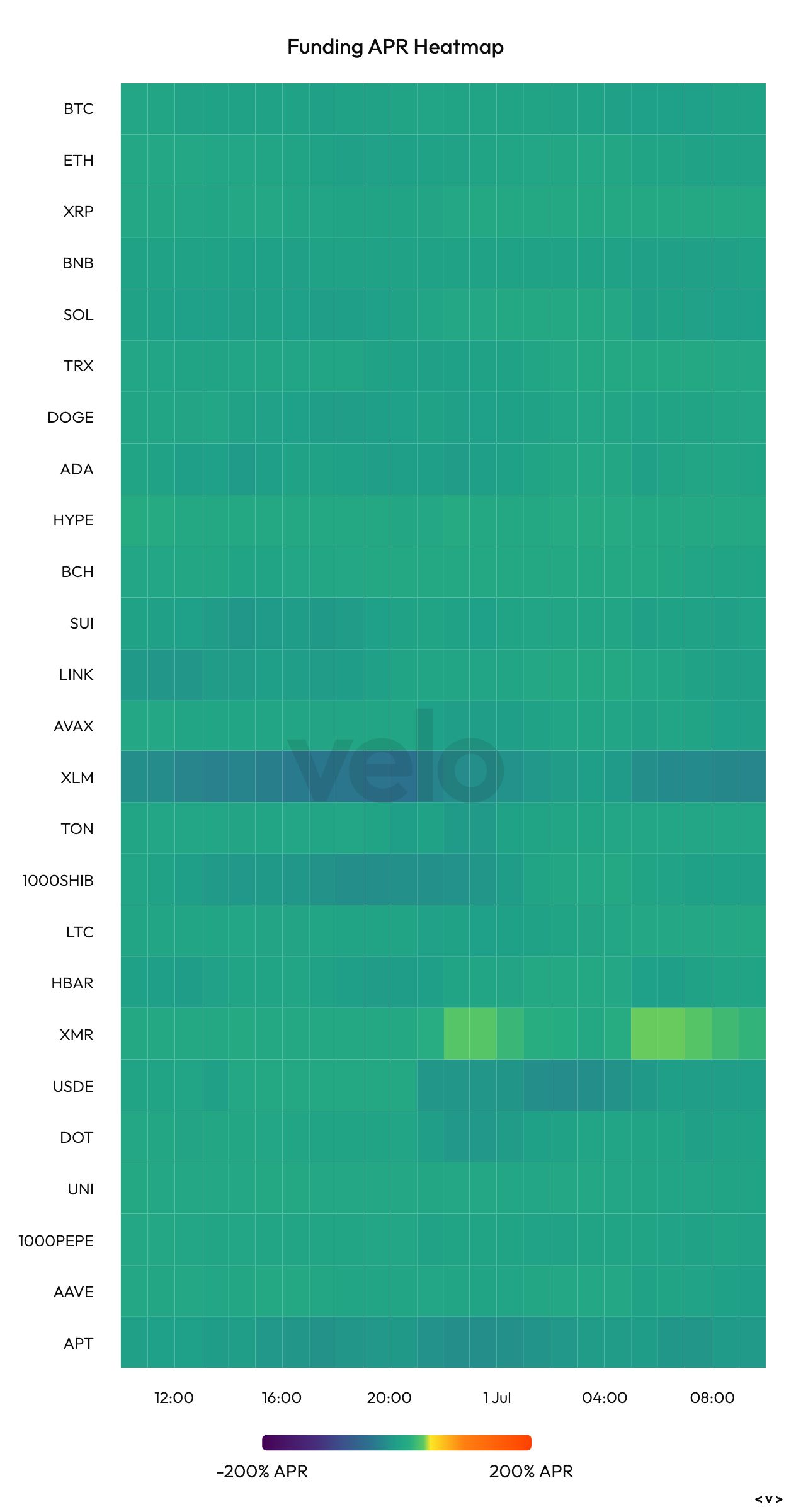Uncategorized
Asia Morning Briefing: Crypto Industry ‘Unprepared’ For Quantum Threat Says Analyst

Good Morning, Asia. Here’s what’s making news in the markets:
Welcome to Asia Morning Briefing, a daily summary of top stories during U.S. hours and an overview of market moves and analysis. For a detailed overview of U.S. markets, see CoinDesk’s Crypto Daybook Americas.
Bitcoin BTC is trading around $106,402.39 as Asia begins its trading day, up roughly 0.9%, recovering slightly from a weekend decline attributed to significant outflows from spot Bitcoin ETFs and increased geopolitical uncertainty.
The largest digital asset by market cap had previously dropped 2% from $105,987 to $103,748 amid notable trading volume spikes, influenced by $616 million in ETF outflows, marking the end of BlackRock’s iShares Bitcoin Trust’s 31-day inflow streak, and heightened tensions from stalled U.S.-China trade talks.
Analysts are increasingly watching BTC’s unconventional correlation with Japan’s 30-year government bond yields, as highlighted by macro strategist Weston Nakamura.
Nakamura suggests that this alignment, stronger recently than traditional connections with U.S. equities, implies a deeper global macro shift in financial markets, indicating Japan’s growing influence over cross-asset dynamics.
As investors navigate these complex macroeconomic factors, bitcoin continues to test crucial support levels near $104,300, reflecting both caution and ongoing market volatility.

Crypto Must Prepare for Quantum Threat ‘Linearly’, Not Reactively: Analyst
Crypto could face catastrophe if it continues to overlook quantum computing’s advancing threat, warns Rick Maeda of Presto Research, who recently published a report on quantum risks, which argued that the industry was unprepared.
A key barrier, he said in an interview with CoinDesk, is an economic incentive issue, as investors remain reluctant to fund quantum-resistant technology because he argued that “it’s difficult to create a way to monetize this.”
«Crypto is underprepared,» he said. «The biggest risk is just waiting too long.»
Maeda argues that blockchains dependent on elliptic curve cryptography (ECC) urgently need systematic preparation to withstand future quantum attacks.
«Preparation has to come almost linearly, because we can’t wait until the threat is real to start taking it seriously,» he told CoinDesk in an interview. «By then, it’s already too late.»
Yet Maeda offers several caveats to balance fears about quantum computing’s immediate capabilities.
He argues that current quantum systems operate at only around 10 logical qubits with high error rates, significantly below the thousands needed to compromise ECC. Additionally, recent quantum advancements, such as Google’s processor developments, come with trade-offs in efficiency versus accuracy.
While immediate panic isn’t necessary, Maeda emphasizes the urgency of incremental, sustained efforts to bolster cryptocurrency’s defenses before quantum threats become a reality.
News Roundup
Meta Shareholders Reject Bitcoin Treasury Proposal in Landslide Vote
Meta shareholders overwhelmingly rejected a proposal to shift some of the company’s $72 billion cash reserves into bitcoin, with only 0.08% of nearly 5 billion votes cast supporting the initiative, CoinDesk previously reported.
Proposed by Ethan Peck of wealth management firm Strive and backed by the conservative National Center for Public Policy Research, the measure aimed to hedge inflation risks by using bitcoin as a strategic treasury asset.
Meta has previously ventured into crypto projects, notably the Libra stablecoin effort in 2019, which later collapsed amid regulatory pressures. Despite recent pullbacks from ambitious metaverse projects, the company continues exploring stablecoin-based payments across its platforms. Meta shares rose 3.5% on Monday, trading at $670.09 each.
Crypto Lobbyists Urge US Senate to Focus on Stablecoin Bill
Crypto industry lobbyists are urging U.S. senators to stay focused as the GENIUS Act, a bill aimed at regulating stablecoin issuers, faces potential distraction from unrelated amendments during its final Senate debate, CoinDesk previously reported.
Advocacy groups like the Blockchain Association and Crypto Council for Innovation emphasized the need to maintain the bill’s narrow goal, especially as senators behind the Credit Card Competition Act try to attach their unrelated legislation as an amendment.
The GENIUS Act, which targets the regulation of stablecoins such as Tether’s USDT and Circle’s USDC, has already garnered bipartisan support in the Senate Banking Committee. Despite complications from unrelated legislative additions, analysts from Capital Alpha Partners give the stablecoin bill a 60-65% chance of becoming law this year, noting that success in the Senate would mark a significant milestone, though the House of Representatives would also need to approve the legislation.
Market Movements:
- BTC: Bitcoin rose 0.9% to $106,402.39, rebounding slightly after ETF outflows and geopolitical tensions triggered a weekend drop, as analysts highlighted its growing correlation with Japanese long-end bond yields.
- ETH: Ethereum gained 3% to $2,539.04 after staging a V-shaped recovery from intraday lows, supported by strong institutional inflows and resilient buying around the key $2,500 level.
- Gold: Gold surged over 2% to $3,371.40 on Monday, hitting a three-week high as the U.S. dollar weakened 0.27%, boosting safe-haven demand amid geopolitical tensions and economic uncertainty.
- Nikkei 225: Japan’s Nikkei 225 rose 0.36% Tuesday morning, as Asia-Pacific markets advanced following overnight Wall Street gains despite a resurgence in global trade tensions.
- S&P 500: U.S. stocks rose Monday, with the S&P 500 gaining 0.4%, as investors brushed aside escalating trade tensions with China and the EU.
Elsewhere in Crypto:
Uncategorized
Robinhood, Kraken-Backed Global Dollar (USDG) Comes to Europe

Global Dollar (USDG), a stablecoin issued by regulated fintech Paxos, and backed by a consortium of heavy hitters that includes Robinhood, Kraken and Mastercard, is being made available to consumers across the European Union, according to a press release on Tuesday.
USDG is regulated by Europe’s Markets in Crypto-Assets (MiCA), the Finnish Financial Supervisory Authority (FIN-FSA), and the Monetary Authority of Singapore (MAS), Paxos said in a statement.
Demand for U.S. dollar-backed stablecoins is growing in Europe where Circle’s USDC token is the largest MiCA-regulated choice. USDG will make a significant impact as an alternative regulated option, Paxos said.
“USDG is a fully regulated global USD-stablecoin that is compliant with MiCA and now available in the EU, a testament to our commitment to offering global digital assets that are supervised by prudential regulators and also meet the highest standards of consumer protection,” said Walter Hessert, head of strategy at Paxos.
Fulfilling requirements under the EU’s MiCA regulation necessitates that Paxos Issuance Europe, which is regulated by FIN-FSA, holds a portion of USDG reserve assets with European banking partners, Paxos said.
Uncategorized
XRP, TRX, DOGE Lead Majors With Positive Funding Rates as Bitcoin’s Traditionally Weak Quarter Begins

A key metric called perpetual funding rates is signaling bullishness for top altcoins as bitcoin (BTC) kicks off the traditionally weak third quarter quarter with flat price action.
Funding rates, charged by exchanges every eight hours, refer to the cost of holding bullish long or bearish short positions in the perpetual (perps) futures (with no expiry).
A positive funding rate indicates that perps are trading at a premium to the spot price, necessitating a payment from longs to shorts to maintain bullish bets. Therefore, positive rates are interpreted as representing bullish sentiment, while negative rates suggest otherwise.
As of writing, perps tied to payments-focused token XRP (XRP), the world’s fourth-largest digital asset by market value, had an annualized funding rate of nearly 11%, the highest among the top 10 tokens, according to data source Velo. Funding rates for Tron’s TRX (TRX) and dogecoin (DOGE) were 10% and 8.4%, respectively, while rates for market leaders bitcoin and ether were marginally positive.
In other words, the XRP market demonstrated the strongest demand for leveraged bullish exposure among other major cryptocurrencies, including BTC and ether (ETH). That’s consistent with the spike in bullish sentiment for XRP last week, despite the settlement between Ripple and the SEC stalling, as noted by Santiment.

Privacy-focused monero (XMR) stood among tokens beyond the top 10 list with a funding rate of over 23%, while Stellar’s XLM token signaled a strong bias for bearish bets with a funding rate of 24%.
Seasonally weak quarter
Historically, the third quarter has been a weak period for bitcoin, with data indicating an average gain of 5.57% since 2013, according to Coinglass. That’s a far cry compared to the fourth quarter’s 85% average gain.
BTC’s spot price remained flat at around $107,000 at press time, offering no clear direction bias. Valuations have been stuck largely between $100,000 and $110,000 for nearly 50 days, with selling by long-term holder wallets counteracting persistent inflows into the U.S.-listed spot exchange-traded funds (ETFs).
Some analysts, however, expect a significant move to occur soon, with all eyes on Fed Chairman Jerome Powell’s speech on Tuesday and the release of nonfarm payrolls on Friday.
Uncategorized
Asia Morning Briefing: Are Distributed Compute Tokens Undervalued vs. CoreWeave (CRWV)?

Tech investors love to pay for potential. GameFi tokens, with sky-high valuations divorced from current user numbers or revenues, embody this optimism perfectly — as CoinDesk investigated in 2022, Decentraland’s then billion-dollar market cap didn’t quite match the number of active players on the platform.
But, surprisingly, distributed compute tokens don’t seem to enjoy the same speculative premium even when compared to their Traditional Finance traded peers like CoreWeave (CRWV).
CoinMarketCap says the category of tokens for decentralized networks that provide GPU power for AI and other compute workloads, which includes well-known tokens like BitTensor, Aethir, and Render, is worth $12 billion.
At the same time, market data from research group MarketsandMarkets puts the value of the GPU as a service industry at around $8 billion this year, growing to $26 billion in 2030.
In contrast, CRWV closed Monday in New York at $163, putting its market cap at $79.2 billion. The company’s recent earnings forecast up to $5.1 billion in 2025 revenue, suggesting it trades at more than 15 times forward sales.
That kind of multiple might be justified in a high-growth environment, but CoreWeave also posted a $314.6 million net loss in the first quarter, driven in part by stock-based compensation and continued infrastructure buildout.
Despite this, investors continue to reward CoreWeave for its dominant position in centralized AI infrastructure with its stock up 300% year-to-date. The company is tightly integrated with Nvidia and has high visibility through contracts with OpenAI and other enterprise clients.
Meanwhile, decentralized compute networks are delivering similar services— AI inference, rendering, and compute power — without needing to raise billions in debt or equity as they act as a broker connecting existing GPUs to users, saving the capital expenditure of buying their own server farms.
These are not theoretical networks. They are functional systems already processing real workloads, and the brokerage model works for customers.
Yet their collective market value remains a fraction of CoreWeave’s. Certainly, they don’t have the same level of workload running through their networks, but the gap is striking. While the market treats GameFi with irrational exuberance, distributed compute tokens may be suffering from the opposite problem.
Despite addressing the same market need as CoreWeave, and in some ways offering a more capital-efficient and globally scalable model without the eye-watering CapEx, they remain modestly valued.
Justin Sun-Backed SRM Entertainment Announces $100 Million TRX Staking Move
SRM Entertainment (Nasdaq: SRM), soon to rebrand as TRON Inc., has staked its entire treasury of 365 million TRX tokens through JustLend, a move that could yield an annual return of up to 10%, according to a release.
The move comes on the heels of a $100 million investment round closed earlier this month to fund what the company calls a “TRON treasury strategy,” essentially, a public market vehicle modeled on bitcoin-holding firms like MicroStrategy, but for TRX.
That structure provides equity investors with indirect exposure to a network that plays a dominant role in USDT stablecoin settlement, particularly in the Global South, where TRON-based Tether serves as a dollar lifeline – arguably a ‘Visa IPO‘ moment for the region’s economy.
Sogni AI Debuts Mainnet, SOGNI Token to List on Kraken, MEXC, Gate.io
Sogni AI, a decentralized platform for generative AI workflows, has launched its mainnet and will list its native token, SOGNI, on Kraken, MEXC, and Gate.io.
SOGNI is the utility token of the Sogni Supernet. It is used for compute payments, staking, governance, and access to advanced application features.
The mainnet launch includes deployments on Base, an Ethereum Layer-2 developed by Coinbase, and Etherlink, a Tezos-based EVM-compatible Layer-2 using Smart Rollups. In a release, the platform said this chain-agnostic approach is designed to balance scalability and accessibility.
The project’s stated goal is to create an open and economically sustainable environment for creative AI applications, combining Web3 infrastructure with user tools that resemble Web2 services in usability.
The platform also uses a non-transferable credit system called Spark Points, which are fixed-value rendering credits that can be purchased or earned within the Sogni ecosystem.
Users interact with the network through three core applications: Sogni Web, Sogni Pocket, and Sogni Studio. Creators submit generative AI jobs, while node operators, or “Workers,” provide GPU resources and are compensated in SOGNI tokens.
Market Movements:
- BTC: Bitcoin is trading at $107,200, holding a strong support zone after a 14,695 BTC volume spike near $107K, with traders eyeing a potential breakout toward $115,000.
- ETH: Ethereum rebounded sharply from a 3.4% intraday drop, currently trading at $2,480, forming a V-shaped recovery off $2,438 support, as institutional inflows continue despite broader market uncertainty.
- Gold: Gold is trading at $3,310.95, rebounding from a one-month low as a weaker dollar and Fed pressure offset risk-on sentiment.
- Nikkei 225: Asia-Pacific markets traded mixed Tuesday as investors weighed Wall Street’s record highs against looming uncertainty from Trump’s expiring 90-day tariff reprieve, with Japan’s Nikkei 225 down 0.58%
- S&P 500: Stocks climbed Monday as the S&P 500 rose 0.52% to a record close of 6,204.95, capping a strong month.
Elsewhere in Crypto:
-

 Business9 месяцев ago
Business9 месяцев ago3 Ways to make your business presentation more relatable
-

 Entertainment9 месяцев ago
Entertainment9 месяцев ago10 Artists who retired from music and made a comeback
-

 Fashion9 месяцев ago
Fashion9 месяцев agoAccording to Dior Couture, this taboo fashion accessory is back
-

 Entertainment9 месяцев ago
Entertainment9 месяцев ago\’Better Call Saul\’ has been renewed for a fourth season
-

 Business9 месяцев ago
Business9 месяцев ago15 Habits that could be hurting your business relationships
-

 Entertainment9 месяцев ago
Entertainment9 месяцев agoDisney\’s live-action Aladdin finally finds its stars
-

 Entertainment9 месяцев ago
Entertainment9 месяцев agoNew Season 8 Walking Dead trailer flashes forward in time
-

 Tech9 месяцев ago
Tech9 месяцев ago5 Crowdfunded products that actually delivered on the hype





